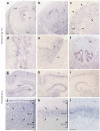X-linked protocadherin 19 mutations cause female-limited epilepsy and cognitive impairment
- PMID: 18469813
- PMCID: PMC2756413
- DOI: 10.1038/ng.149
X-linked protocadherin 19 mutations cause female-limited epilepsy and cognitive impairment
Abstract
Epilepsy and mental retardation limited to females (EFMR) is a disorder with an X-linked mode of inheritance and an unusual expression pattern. Disorders arising from mutations on the X chromosome are typically characterized by affected males and unaffected carrier females. In contrast, EFMR spares transmitting males and affects only carrier females. Aided by systematic resequencing of 737 X chromosome genes, we identified different protocadherin 19 (PCDH19) gene mutations in seven families with EFMR. Five mutations resulted in the introduction of a premature termination codon. Study of two of these demonstrated nonsense-mediated decay of PCDH19 mRNA. The two missense mutations were predicted to affect adhesiveness of PCDH19 through impaired calcium binding. PCDH19 is expressed in developing brains of human and mouse and is the first member of the cadherin superfamily to be directly implicated in epilepsy or mental retardation.
Figures




Comment in
-
The cadherin superfamily and epileptogenesis: end of the beginning?Epilepsy Curr. 2009 May-Jun;9(3):87-9. doi: 10.1111/j.1535-7511.2009.01302.x. Epilepsy Curr. 2009. PMID: 19471581 Free PMC article. No abstract available.
References
-
- Ryan SG, et al. Epilepsy and mental retardation limited to females: an X-linked dominant disorder with male sparing. Nat. Genet. 1997;17:92–95. - PubMed
-
- Juberg RC, Hellman CD. A new familial form of convulsive disorder and mental retardation limited to females. J. Pediatr. 1971;79:726–732. - PubMed
-
- Fabisiak K, Erickson RP. A familial form of convulsive disorder with or without mental retardation limited to females: extension of a pedigree limits possible genetic mechanisms. Clin. Genet. 1990;38:353–358. - PubMed
-
- Scheffer IE, et al. Epilepsy and mental retardation limited to females: an under-recognised disorder. Brain. 2008;131:918–927. - PubMed
-
- Wolverton T, Lalande M. Identification and characterization of three members of a novel subclass of protocadherins. Genomics. 2001;76:66–72. - PubMed
Publication types
MeSH terms
Substances
Grants and funding
LinkOut - more resources
Full Text Sources
Other Literature Sources
Medical
Molecular Biology Databases

